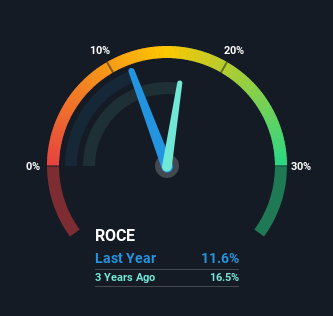- United Kingdom
- /
- Construction
- /
- LSE:CTO
Here's What To Make Of TClarke's (LON:CTO) Decelerating Rates Of Return
There are a few key trends to look for if we want to identify the next multi-bagger. In a perfect world, we'd like to see a company investing more capital into its business and ideally the returns earned from that capital are also increasing. If you see this, it typically means it's a company with a great business model and plenty of profitable reinvestment opportunities. With that in mind, the ROCE of TClarke (LON:CTO) looks decent, right now, so lets see what the trend of returns can tell us.
Return On Capital Employed (ROCE): What is it?
For those who don't know, ROCE is a measure of a company's yearly pre-tax profit (its return), relative to the capital employed in the business. Analysts use this formula to calculate it for TClarke:
Return on Capital Employed = Earnings Before Interest and Tax (EBIT) ÷ (Total Assets - Current Liabilities)
0.12 = UK£5.7m ÷ (UK£153m - UK£104m) (Based on the trailing twelve months to June 2021).
So, TClarke has an ROCE of 12%. In absolute terms, that's a satisfactory return, but compared to the Construction industry average of 8.9% it's much better.
See our latest analysis for TClarke

In the above chart we have measured TClarke's prior ROCE against its prior performance, but the future is arguably more important. If you'd like, you can check out the forecasts from the analysts covering TClarke here for free.
What Does the ROCE Trend For TClarke Tell Us?
While the current returns on capital are decent, they haven't changed much. The company has consistently earned 12% for the last five years, and the capital employed within the business has risen 41% in that time. Since 12% is a moderate ROCE though, it's good to see a business can continue to reinvest at these decent rates of return. Over long periods of time, returns like these might not be too exciting, but with consistency they can pay off in terms of share price returns.
Another thing to note, TClarke has a high ratio of current liabilities to total assets of 68%. This can bring about some risks because the company is basically operating with a rather large reliance on its suppliers or other sorts of short-term creditors. While it's not necessarily a bad thing, it can be beneficial if this ratio is lower.
The Bottom Line On TClarke's ROCE
In the end, TClarke has proven its ability to adequately reinvest capital at good rates of return. And since the stock has risen strongly over the last five years, it appears the market might expect this trend to continue. So while investors seem to be recognizing these promising trends, we still believe the stock deserves further research.
If you'd like to know more about TClarke, we've spotted 6 warning signs, and 2 of them are significant.
While TClarke may not currently earn the highest returns, we've compiled a list of companies that currently earn more than 25% return on equity. Check out this free list here.
Valuation is complex, but we're here to simplify it.
Discover if TClarke might be undervalued or overvalued with our detailed analysis, featuring fair value estimates, potential risks, dividends, insider trades, and its financial condition.
Access Free AnalysisHave feedback on this article? Concerned about the content? Get in touch with us directly. Alternatively, email editorial-team (at) simplywallst.com.
This article by Simply Wall St is general in nature. We provide commentary based on historical data and analyst forecasts only using an unbiased methodology and our articles are not intended to be financial advice. It does not constitute a recommendation to buy or sell any stock, and does not take account of your objectives, or your financial situation. We aim to bring you long-term focused analysis driven by fundamental data. Note that our analysis may not factor in the latest price-sensitive company announcements or qualitative material. Simply Wall St has no position in any stocks mentioned.
About LSE:CTO
TClarke
Engages in the design, installation, integration, and maintenance of the mechanical and electrical systems and technologies in the United Kingdom.
High growth potential with excellent balance sheet and pays a dividend.
Similar Companies
Market Insights
Community Narratives



